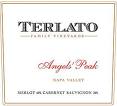We’ve had this discussion before about Cabernet Franc. I’m in the camp that holds Franc has untapped potential to produce seriously good wine from the Napa Valley. I would even go so far as to predict it could be the next big thing from Napa.
So far there is precious little evidence that I am right. Yet I was encouraged recently after an encounter with Aaron Pott, the erudite winemaker for a number of Napa brands, including the wines of Blackbird Vineyards.
 Blackbird is a significant player in this story because the wines are inspired by the Right Bank Bordeaux districts of Pomerol and Saint-Emilion, where the predominant grape varieties are Merlot and Cabernet Franc. Cabernet Sauvignon is little used or not at all because the cool clay soils of the region foil just about all attempts to properly ripen the grape.
Blackbird is a significant player in this story because the wines are inspired by the Right Bank Bordeaux districts of Pomerol and Saint-Emilion, where the predominant grape varieties are Merlot and Cabernet Franc. Cabernet Sauvignon is little used or not at all because the cool clay soils of the region foil just about all attempts to properly ripen the grape.
Pott has intimate knowledge of Cab Franc and Merlot from the Right Bank, where he once upon a time made wines for Saint-Emilion grand cru producers Troplong Mondot and La Tour Figeac. At Chateau La Tour Figeac he also doubled as the general manager.
He is no less experienced in the grapes of the Napa Valley, having logged stints at Newton, St. Clement and Quintessa in addition to a number of consulting gigs. At Blackbird, where Pott has taken the reins from star winemaker and good friend Sarah Gott, he inherits the 10-acre Blackbird Vineyard, certainly among the top five Merlot vineyards in the valley.
The Blackbird vineyard Merlot is the base grape for Blackbird’s flagship wine, the $90 Illustration. Once 100 percent Merlot, the most recent release, 2007, finds 20 percent Cab Franc in the blend. Other Blackbird wines lean more heavily upon Cab Franc: 2007 Contrarian ($90) is 46 percent Cab Franc compared to 34 percent Merlot and only 20 percent Cabernet Sauvignon; 2007 Paramour is 50 percent Cab Franc, 45 Merlot and 5 Cabernet Sauvignon.
 Pott, as any good Right Bank winemaker would, believes the Cabernet Franc adds structural elegance and longevity. Yet, stylistic benefits aside, Pott offers a more practical argument for utilizing more Cabernet Franc and Merlot in Napa Valley red wines.
Pott, as any good Right Bank winemaker would, believes the Cabernet Franc adds structural elegance and longevity. Yet, stylistic benefits aside, Pott offers a more practical argument for utilizing more Cabernet Franc and Merlot in Napa Valley red wines.
“We are finding out that these cool-climate Bordeaux grapes do better in areas like Carneros and the southern end of the Napa Valley than Pinot Noir,” said Pott. “Carneros simply isn’t cool enough for really, really good Pinot.”
Whether he’s right or wrong, there is little doubt that the Pinots of the much cooler Russian River Valley and Sonoma Coast, each with a more profound Pacific Ocean influence, have overshadowed the Pinots of Carneros.
The Blackbird vineyard is right at the northern border of the cool zone, located in the Oak Knoll District near the city of Napa. Most of the Cabernet Franc used is purchased from growers in southern Napa Valley and Carneros.
There’s also a fair bit of clay in the soils at the southern end of the valley, which when combined with the cooler days and still cooler evenings leads to wines with fresher acidity and firmer, more prickly tannins and little or none of the jammy characteristics found in Napa reds north of the Oak Knoll District.
 Pott’s rhetoric is matched by bold action. Consider the Blackbird lot that was auctioned recently at Premiere Napa Valley was 45 percent Cab Franc, 45 percent Merlot and only 10 percent Cabernet Sauvignon.
Pott’s rhetoric is matched by bold action. Consider the Blackbird lot that was auctioned recently at Premiere Napa Valley was 45 percent Cab Franc, 45 percent Merlot and only 10 percent Cabernet Sauvignon.
If Pott and Blackbird were the only true believers in the Right Bank model for the Napa Valley, I would be out on a shaky limb.
That’s hardly the case. One of the finest Napa Valley reds I’ve tasted in the past year is the Devil’s Peak ($60) from Terlato. Devil’s Peak is a remarkable mirror image of the famed Cheval Blanc of Saint-Emilion, with better than 60 percent Cabernet Franc. Angel’s Peak, a sister blend, follows the Pomerol model at 95 percent Merlot and 5 percent Cab Franc and it retails for $50.
Both wines exhibit the structure and elegance of Right Bank Bordeaux, and thus stand stylistically apart from the Napa Valley norm for a grand cru caliber red wine.
 Jarvis, long a champion of the Cabernet Franc grape, produces perhaps the finest stand-alone Cab Franc in America. And yes, at 90 percent Cab Franc and 10 percent Cabernet Sauvignon, it is stylistically about as far from a typical Napa Valley grand cru red as any $65 Napa Valley wine gets.
Jarvis, long a champion of the Cabernet Franc grape, produces perhaps the finest stand-alone Cab Franc in America. And yes, at 90 percent Cab Franc and 10 percent Cabernet Sauvignon, it is stylistically about as far from a typical Napa Valley grand cru red as any $65 Napa Valley wine gets.
Another Jarvis wine, the $105 Will Jarvis’ Science Project, is even more extreme and decidedly Right Bank at 95 percent Cab Franc and 5 percent Merlot. That wine scored an impressive Platinum award at the Winemaker Challenge International Wine Competition in January.
Then there is the Pomerol inspired Twomey, where winemaker Daniel Baron (also of Silver Oak) brings his own Bordeaux experiences (making wine in Pomerol and Saint-Emilion) to bear with a world class Merlot, one of the Napa Valley’s top five, that checks in at a very Right Bank 96 percent Merlot and 4 percent Cab Franc.
This powerful yet restrained Merlot is sourced from a single vineyard in the southern Napa Valley.
To my way of thinking it is very telling that even a handful of high-end luxury Napa Valley wineries are playing around with the Right Bank model. It goes against the conventional wisdom that the valley’s highest and best vineyard use is Cabernet Sauvignon.
 And that speaks to the wisdom of a few men with vision and courage to step outside the Napa Valley’s safe zone and plant the grapes that actually work in their vineyards.
And that speaks to the wisdom of a few men with vision and courage to step outside the Napa Valley’s safe zone and plant the grapes that actually work in their vineyards.
Call me crazy, but I detect a trend. Will others follow suit and do the Right thing? I say you can bank on that.
Email Robert at WhitleyOnWine@yahoo.com.